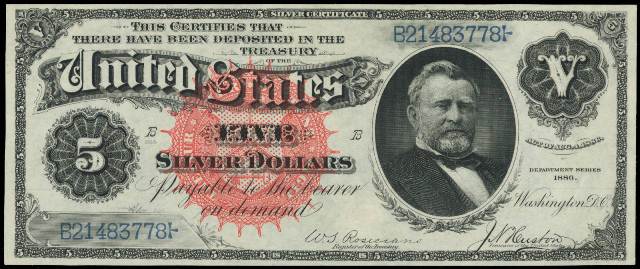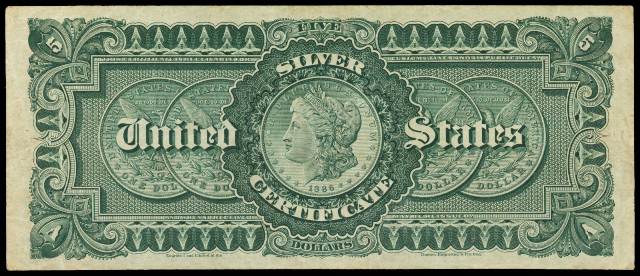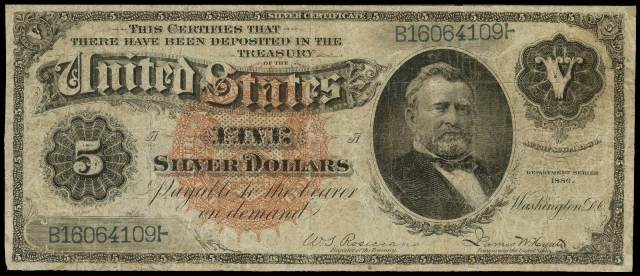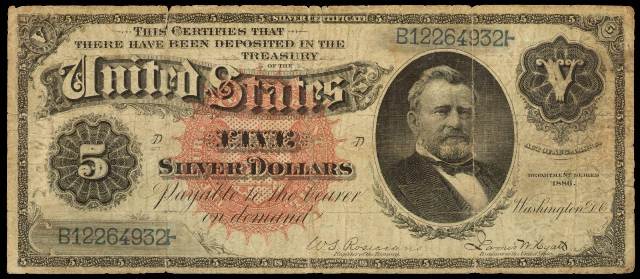Series of 1886 $5 Silver Certificate – Morgan Back Note
History: Most people associate silver certificates with blue seals. And it is true that many silver certificates were printed with blue seals. However, the earliest issues which were printed in 1878, 1880, and 1886 all had red seals. The example we are looking at here is a series of 1886 $5 silver certificate. This is actually the first five dollar silver certificate ever issued by The United States. It is a crucial note needed to complete a silver certificate set or a five dollar bill set. This type design was used again in 1891. However, the 1886 design is much more valuable for one reason. It has a very unique design that appeals to a lot of people. Read below for more details.
Nickname: The 1886 $5 silver certificate is mostly frequently called a “Morgan Back.” That nickname comes from the fact that there are five silver dollars pictured on the reverse of this bill. As you can imagine, a piece of paper money that also has ties to coins is going to appeal to quite a lot of people. There are probably 100 times more coin collectors than there are paper money collectors. It is safe to say that the 1886 five dollar bill is a on a few want lists.
Other Facts: It is also important to mention that Ulysses S. Grant is featured on the 1886 $5 silver certificate. We of course closely associate Grant with the $50 bill. However, he didn’t appear on that denomination until 1913 gold certificates were issued. The 1886 $5 bill is important because it is what is known as a one year design type (at least on the reverse). That popular reverse image with the Morgan dollar coin vignette was never used again. It is also fun to note that the pictured Morgan dollar is of course from 1886. These were issued during a time when coins were still preferred to paper currency. The coin images were no doubt included so people would feel more secure. Even today, people would rather have an equal value of gold or silver as opposed to paper money.
Values and Grading: 1886 $5 silver certificates are fairly rare. Millions were printed, but there are probably less than one thousand still known to exist. High grade examples are rare. It is not uncommon for high grade large size notes to have been saved in large quantities. That does not appear to be the case with Morgan back fives. Values range from $200 for a note in very poor condition, to thousands of dollars for uncirculated examples. We have four notes pictured below. They should help you get a better understanding of how the condition affects the value.
Choice Uncirculated or Better: As we briefly mentioned above, there are not many truly uncirculated 1886 $5 silver certificates available in the market today. Because of this fact, there is a significant premium for something grading this high. A note in AU 55 condition might sell for $5,000; but something in Gem 65 condition could sell for 5 times that. Choice uncirculated implies that the note looks like it was printed this morning. The paper should be crisp and never folded. The inks and overprints should be bright. Even the smallest blemish could keep it outside of the gem grade.

1886 $5 Silver Certificates In This Grade Are Very Rare
Extremely Fine to About Uncirculated: As we stated above, 1886 $5 silver certificates are almost prohibitively expensive in the uncirculated graded. So many collectors have to settle for something with a couple of folds or slight handling. Folds are much easier to spot on the front of this series. The dark green back is good at concealing light bends and folds. Always hold a note to the light at an angle to help expose some of the condition issues that might otherwise be difficult to see. The note we have pictured below actually graded as a 40. That seems fairly generous considering the toned paper and lack of eye appeal.

1886 $5 Silver Certificates In This Condition Sell For A Few Thousand Dollars
Fine to Very Fine: There are lots of 1886 $5 silver certificates available in the Fine 12 to Very Fine 35 grade. That is a big range in terms of condition. Something in Fine 12 will look horrible compared to VF 35. The 35 will likely cost a few times more than the 12. The 1886 five dollar bill we have pictured actually graded as a Very Fine 20. It looks more like a 15 to us, but perhaps the paper is stronger than it appears. Notes in this grade range will have slightly faded colors, somewhat dirtier paper, and lots of old fold lines. Problems like tears, stains, missing pieces, etc should still be discounted in price further no matter what the technical numeric grade is.

We Usually Pay Around $1,500 For Notes In This Condition
Very Good and Lower: The easiest way to spot an 1886 $5 silver certificate in this grade is to look at the back. The back shows all the wear. Often times the normally dark green design will become cracked and worn from all the fold lines. It is not uncommon to see rust, tape, lots of pinholes, and other undesirable condition problems that are the result of spending a very long time in circulation. This is often the grade that collectors looking to fill holes or buy for the novelty factor have to settle for. There is certainly no shame in that.

1886 $5 Silver Certificates In This Condition Should Sell For A Few Hundred Dollars
Need an Appraisal or Offer? We frequently pay lots of money for 1886 $5 silver certificates. We would love a chance to make an offer on yours. Just send scans or digital photos of the front and back and we will respond back quickly with the value and what we can offer. You might be surprised by the value. Sales@AntiqueMoney.com


